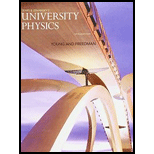
BIO QUENCHING AN MRI MAGNET. Magnets carrying very large currents are used to produce the uniform, large-magnitude magnetic fields that are required for magnetic resonance imaging (MRI). A typical MRI magnet may be a solenoid that is 2.0 m long and 1.0 m in diameter, has a self-inductance of 4.4 H. and carries a current of 750 A. A normal wire carrying that much current would dissipate a great deal of electrical power as heat, so most MRI magnets are made with coils of superconducting wire cooled by liquid helium at a temperature just under its boiling point (4.2 K). After a current is established in the wire, the power supply is disconnected and the magnet leads are shorted together through a piece of superconductor so that the current flows without resistance as long as the liquid helium keeps the magnet cold.
Under rare circumstances, a small segment of the magnet’s wire may lose its superconducting properties and develop resistance. In this segment, electrical energy is converted to thermal energy, which can boil off some of the liquid helium. More of the wire then warms up and loses its superconducting properties, thus dissipating even more energy as heat. Because the latent heat of vaporization of liquid helium is quite low (20.9 kJ/kg), once the wire begins to warm up. all of the liquid helium may boil off rapidly. This event, called a quench, can damage the magnet. Also, a large volume of helium gas is generated as the liquid helium boils off, causing an asphyxiation hazard, and the resulting rapid pressure buildup can lead to an explosion. You can see how important it is to keep the wire resistance in an MRI magnet at zero and to have devices that detect a quench and shut down the current immediately.
30.73 If a small part of this magnet loses its superconducting properties and the resistance of the magnet wire suddenly rises from 0 to a constant 0.005 Ω, how much time will it take for the current to decrease to half of its initial value? (a) 4.7 min; (b) 10 min; (c) 1I5min;(d)30min.
Want to see the full answer?
Check out a sample textbook solution
Chapter 30 Solutions
University Physics (14th Edition)
Additional Science Textbook Solutions
Microbiology: An Introduction
Chemistry: Structure and Properties (2nd Edition)
Campbell Essential Biology (7th Edition)
Genetic Analysis: An Integrated Approach (3rd Edition)
Campbell Essential Biology with Physiology (5th Edition)
Anatomy & Physiology (6th Edition)
- How to solve this, given answerarrow_forwardThree point-like charges are placed at the corners of a square as shown in the figure, 28.0 cm on each side. Find the minimum amount of work required by an external force to move the charge q1 to infinity. Let q1=-2.10 μC, q2=+2.40 μС, q3=+3.60 μC.arrow_forwardA point charge of -4.00 nC is at the origin, and a second point charge of 6.00 nC is on the x axis at x= 0.820 mm . Find the magnitude and direction of the electric field at each of the following points on the x axis. x2 = 19.0 cmarrow_forward
- Four point-like charges are placed as shown in the figure, three of them are at the corners and one at the center of a square, 36.0 cm on each side. What is the electric potential at the empty corner? Let q1=q3=+26.0 µС, q2=-28.0 μC, and q4=-48.0μc Varrow_forwardPLS HELparrow_forwardPlease solve and answer the question correctly please. Thank you!!arrow_forward
 College PhysicsPhysicsISBN:9781938168000Author:Paul Peter Urone, Roger HinrichsPublisher:OpenStax College
College PhysicsPhysicsISBN:9781938168000Author:Paul Peter Urone, Roger HinrichsPublisher:OpenStax College
 Physics for Scientists and Engineers: Foundations...PhysicsISBN:9781133939146Author:Katz, Debora M.Publisher:Cengage Learning
Physics for Scientists and Engineers: Foundations...PhysicsISBN:9781133939146Author:Katz, Debora M.Publisher:Cengage Learning Principles of Physics: A Calculus-Based TextPhysicsISBN:9781133104261Author:Raymond A. Serway, John W. JewettPublisher:Cengage Learning
Principles of Physics: A Calculus-Based TextPhysicsISBN:9781133104261Author:Raymond A. Serway, John W. JewettPublisher:Cengage Learning Physics for Scientists and EngineersPhysicsISBN:9781337553278Author:Raymond A. Serway, John W. JewettPublisher:Cengage Learning
Physics for Scientists and EngineersPhysicsISBN:9781337553278Author:Raymond A. Serway, John W. JewettPublisher:Cengage Learning Physics for Scientists and Engineers with Modern ...PhysicsISBN:9781337553292Author:Raymond A. Serway, John W. JewettPublisher:Cengage Learning
Physics for Scientists and Engineers with Modern ...PhysicsISBN:9781337553292Author:Raymond A. Serway, John W. JewettPublisher:Cengage Learning





